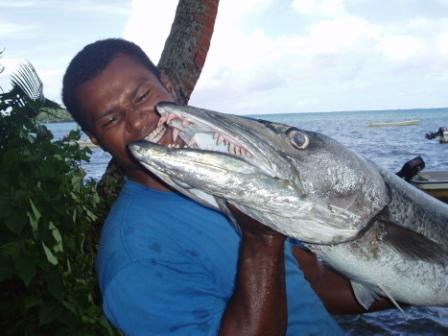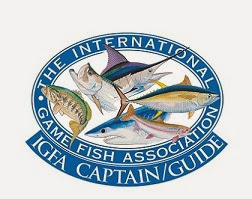Deckie Joe displays a wahoo’s unusual ability to hinge both its upper and lower jaws

For us here on Kadavu Island, May to October is wahoo & sailfish season. Packs of wahoo congregate along the Great Astrolabe Barrier Reef and year round, we find Spanish mackerel. The average size of wahoo here is about 50lbs with a really good fish weighing in at 90 to 100lbs. The mackerel are common to20lbs but can reach 70lbs. The trick here is to first find the wahoo packs by trolling a spread of lures. The wahoo packs are usually on one side of a reef point or the other, depending on the current direction. Normally the up-current side on the drop-off where the depth is about 250ft. Once a pack is found, we then usually switch to 2 outfits on light tackle, rigged with garfish (Ballyhoo). We troll one skip bait and one swimming bait. This prevents the expensive problem of getting mauled by a pack, having 5 rods go off with associated chaos on deck and loosing almost everything you have in the water. (I learnt this the hard way !)
Once you have several fish hooked up and screaming around on the surface, the whole back will attack and bite anything moving – including lines and snap swivels. A shotgun lure with all that belly of line in the water will be bitten off almost immediately.
Wahoo and Mackerel have razor sharp teeth so it is essential that you use wire trace on all lures and baits. We generally use at least 4 feet of 125lb 49 strand stainless steel wire. All snap swivels or other connections are blackened. Trolling speed is usually around 5kts with these bait rigs. The swimming bait is run in the long corner position and the skip bait is run from the opposite side rigger. That extra height allows you to skip the bait well back and out from the prop wash in clear water.
The wahoo normally come steaming in just under the surface but the mackerel usually attack from below. It’s common to see mackerel fly clean out of the water with the bait in their mouth.
Wahoo / Mackerel Lure / Bait Rig
Garfish (ballyhoo) on a two hook pin rig with a small pink skirt on the nose
 What you need:
What you need:
125lb 49 strand (7x7) wire
Stiff single strand wire
8/0 Mustad 7766 Duratin hooks
Bait spring or rubber band or waxed thread
#2 Figure 8 black brass crimps
Crimping tool
Small red/pink skirt or heavy bullet head lure
The Pin Rig
 Making The Rig
Making The RigCut off a 1 inch piece of stiff single strand wire.
Take about 4 feet of the multi strand wire and crimp a hook to the end. Before you crimp, insert the small piece of single strand wire into the crimp pointing away from the hook. You may have to use a larger size crimp to accommodate the extra wire. Bend the end of the small wire so that with the hook pointing down, the wire points up at 90 degrees to the main wire leader.
Cut off a second piece of multi strand wire appropriate to the size of bait you have, crimp another hook on one end and crimp the other end to the loop holding the first hook.
Slide a bait spring onto the main line together with a small pink / red skirt and crimp a small loop at the end of your leader snap swivel.
 Baiting The Rig
Baiting The Rig
Cut the beak off the garfish. Take the leading hook, insert the point between the body and one gill plate and down inside the fish as far as you can. Bring the point out through the belly of the fish.
Take the pin wire and push it up through the bottom jaw and straight through the top jaw.
Slide the bait spring down and rotate it so that it catches the exposed part of the pin and snugs down onto the beak of the bait.
Firmly attach the trailing hook to the bait with a rubber band or waxed thread.
Slide the skirt down over the beak to cover the bait spring and provide a flash of colour to the bait.
Helpful Tips:
Try to get the leading hook coming out of the bait as centrally as possible and make sure the pin is central.
If either are off-centre, the bait will want to spin when trolled.
For skip baits, ensure the bait is skipping along with the exposed trailing hook and wire on the upper side, not the lower side the target fish see.
Prepare your rigs ashore then bait up when you are out there. It’s a lot easier.
If you are freezing fresh garfish for later, sprinkle them with salt. They keep much better.
Variations on a theme: To make a swimming bait rig, we replace the little pink skirt with a heavy bullet head lure or a McWhog (available from Welsystackle http://www.wellsystackle.com/shop/ ) and flat-line the mainline from the rod tip using a #16 rubber band around the reel handle. On a strike, the rubber band snaps. Simple and effective but not suitable for ultra light tackle.
You don’t have to use the second trailing hook however most of the razor gang attack prey by taking the back end first then come around to finish off the rest of the sinking bait. Without that trailing hook you will miss a lot of hook-ups.
Instead of a bait spring, you can use an elastic band. Loop it over the pin, round the beak several times till its tight then put the end back over the pin. Alternatively you can use waxed thread. (Dental floss works just fine)
You can insert a hollow needle through the fish, feed a wire through and attach a hook to one end and crimp the other to the eye of the leading hook. This ‘buries’ the wire to the trailing hook inside the fish. Better presentation but a more fiddly job. We find the wire showing does not seem to put the fish off here.
We secure the trailing hook with a rubber band however you can conceal it by burying it in the belly of the fish. but occasionally this interferes with hook-ups.
Trolling Tips
Mackerel are often not hooked in the mouth but just nicked under the chin or the side of the head. We therefore fight mackerel on relatively light drag settings. If you try to bully a mackerel to the boat, there is a good chance you will pull the hooks and loose the fish. (This is especially important if you are trolling bibbed minnows with treble hooks)
Mackerel up to 20lbs usually school so if you find one, there are usually more in the same area. The larger fish are solitary.
Mackerel make excellent sashimi.
Wahoo come in at high speed and leave the scene at even higher speed. Start with a light drag setting (no more than ¼ line strength). If you try to stop a wahoo on its first run by upping the drag, you will bust it off. Wait for the end of the run, then ease the drag up a little and start working the fish in. If the fish makes another run – back off the drag again. Bear in mind that at the high speeds these fish can reach, line drag through the water can be significant and a sudden burst of speed from a wahoo can bust you off if your drag setting is over 1/3 line strength. When you are fighting a wahoo , you should be actively working the drag – especially on light tackle.
If you run a shotgun lure, make the wire trace extra long. When the shotgun hooks-up, you will have a lot of line in the water and it will get bitten by other fish.
Most wahoo fight near the surface. If your wahoo goes deep – it’s a big one.
Other Sources of information:
Special Review on Wahoo by Dr Julian Pepperell Feb/Mar 2007 issue.
In Depth look at the Narrow Barred Mackerel in the Dec/Jan 2007 issue www.bluewatermag.com.au
If you have any questions, drop me a line at Matava@connect.com.fj






